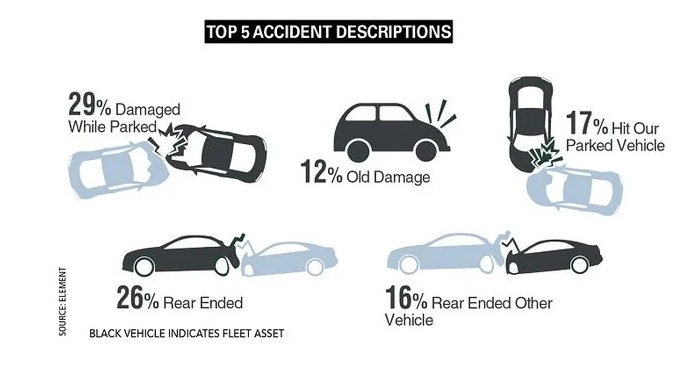Crashes that involved being rear-ended and hitting parked vehicles continued to dominate the top-five accident descriptions in the fleet industry. Source: The CEI Group
Crashes that occur during parking situations still dominate the fleet industry. These crash types have been prevalent in the industry, and are a perennial concern to fleets everywhere, according to Automotive Fleet’s annual Accident Management Survey.
Vehicle damages that occurred while fleets were parked was a frequent accident description reported in calendar-year 2019. This was followed by other vehicles rear-ending fleet assets.
Fleet drivers rear-ending other vehicles was also a top-five accident description for fleets in 2019.
How Fleet Safety Data is Trending
Other data in the latest accident rates for drivers aged 26-35 were listed as the age group with the highest percentage being involved in crashes in 2019. Accident rates for drivers increased for those aged between 18-25 and 46-54, with the former bracket seeing the biggest reported jump, increasing by more than 1% when compared to the previous year survey.

Drivers aged 26-35 were listed as the age group with the highest percentage of being involved in crashes in 2019. Accident rates for drivers increased for those aged between 18-25 and 46-54. However, drivers aged 36- 45, and those aged over 55, saw crash rates diminish in 2019. Drivers aged between 18-25 saw the biggest jump in crashes this year, increasing by more than 1%. Source: Fleet Response
Drivers aged between 36-45, and those aged over 55, saw crash rates diminish in 2019.
Looking at accident percentages by time of day, for sales drivers were more likely to be in an accident between 2 p.m. and 3 p.m., and service drivers experienced accidents most between the hour of 5 p.m. and 6 p.m.
Meanwhile, the percentage of accidents that occurred in non-clear weather condition categories increased across the board, with the biggest percentage increase seen in hail weather.
Despite these trends, recent data found traffic fatalities decreased by an estimated 1.2% last year compared to 2018, according to a report from the National Highway Traffic Safety Administration (NHTSA).

Sales drivers were more likely to be in an accident between 2 p.m. and 3 p.m., and service drivers experienced accidents most between the hour of 5 p.m. and 6 p.m. Source: Fleet Response
The report found a statistical projection that showed 36,120 people died in motor vehicle traffic crashes in 2019 compared to the 36,560 that were reported for 2018.
A Desire for More Safety Tech
Acquiring vehicles that feature advanced driver-assistance systems continues to be an essential way to reduce risk for fleets, beyond just having an effective fleet safety program and safety policy.

The percentage of accidents that occurred in non-clear weather condition categories increased across the board, with the biggest percentage increase seen in hail weather. Source: The CEI Group
More than 50% of commercial drivers feel that smart vehicle technologies have had a positive impact on driver safety, and nearly 70% of commercial drivers want better blindspot detection, according to a study of more than 350 fleet drivers conducted by Harris Interactive and Netradyne.
Another study from Consumer Reports found that widespread adoption of crash avoidance technologies available today and other existing safety systems could save upward of 16,800 to 20,500 lives annually, according to a Consumer Reports analysis. This would average to nearly one-half of the 36,120 lives lost on U.S. roads in 2019.
by Andy Lundin
Source: https://www.automotive-fleet.com
CUT COTS OF THE FLEET WITH OUR AUDIT PROGRAM
The audit is a key tool to know the overall status and provide the analysis, the assessment, the advice, the suggestions and the actions to take in order to cut costs and increase the efficiency and efficacy of the fleet. We propose the following fleet management audit.




